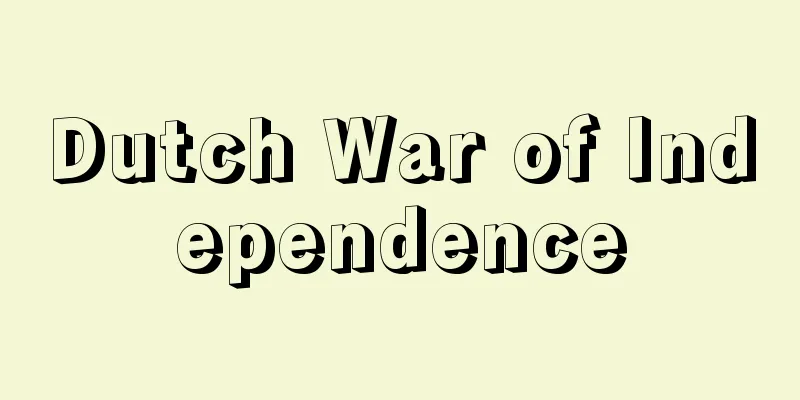Dutch War of Independence

|
The Spanish Netherlands rebelled against the King, and the seven northern provinces gained independence (1568-1648). It is officially called the Eighty Years' War. Most of the Low Countries came under the rule of the Duke of Burgundy during the 14th and 15th centuries, and then became the property of the House of Habsburg after 1477. Holy Roman Emperor Charles V of the Habsburgs established a consulship, a privy council, a financial council, and a council of state in the government office in Brussels, appointed governors to each province, and promoted centralized governance. He also strictly prohibited Protestantism, especially Calvinism, which was spreading in the Netherlands. In 1555, Charles handed over governance of the Netherlands to his son Philip II, and the following year he abdicated as king of Spain. Philip further strengthened centralized governance in the Netherlands and reformed the bishopric system. Philip's rule was opposed by William I of Orange, Count Egmont and other high-ranking nobles, and in 1566, about 400 middle and lower-ranking nobles formed an aristocratic alliance and stormed the government office in Brussels, demanding the abolition of the Inquisition and the convening of a national assembly. Calvinists took advantage of the momentum and held open-air sermons, but the economic crisis caused by the interruption of Baltic trade led to poverty among the people, and their religious fervor led to the outbreak of the Iconoclastic movement. Philip II had the Duke of Alba lead 10,000 soldiers and sent them to the Netherlands to suppress the rebellion. Alba violently oppressed Protestants, established a new Inquisition Council and established a reign of terror. The Calvinists fled to foreign countries, and united under the leadership of the nobles under the name of "ze Goissen" (Sea Beggars), and continued their rebellion. In 1568, the Prince of Orange, who was in exile in Germany, sent an army led by his brother Ludwig into the Netherlands, starting the Eighty Years' War. In 1572, Zee Goissen occupied most of the cities in both Holland and Zeeland, and appointed the Prince of Orange as governor of both provinces, entrusting him with leading the rebellion. Haarlem was recaptured by a fierce counterattack from the Spanish army, but Alkmaar and Leiden continued to resist heroically. In 1576, thanks to the efforts of the Prince of Orange, the Peace of Ghent (also known as the Treaty of Ghent) was concluded between the two rebel provinces and the provinces under Spanish rule, realizing peace and unity in the Netherlands. In 1579, the seven northern provinces formed the Union of Utrecht, pledging to continue the war against Spain, and the Netherlands was divided into North and South. In 1581, the Union of Utrecht declared its refusal to vassalage to Philip II, and attempted to accept as sovereign the Duke of Anjou, the younger brother of King Henry III of France, and Queen Elizabeth I of England, but failed. In the end, the Federal Republic (1588-1795) was established, with each of the seven cantons having its own cantonal sovereignty and cantonal parliament, and a federal parliament made up of the seven cantons as the highest decision-making body for common matters such as military and diplomatic affairs. After the Prince of Orange was assassinated in 1584, Oldenbarneveld assisted the Prince of Orange's surviving son Maurice and led the alliance in fighting against the Spanish army. In 1609, a 12-year truce was concluded with Spain, and the Netherlands achieved effective independence. In 1621, when the war against Spain resumed, the Netherlands went on the offensive, occupying territories under Spanish rule, adding them to its seven cantons. In 1648, the Treaty of Westphalia was concluded, and the Republic's independence was recognized internationally. [Fukuya Kurihara] Source: Shogakukan Encyclopedia Nipponica About Encyclopedia Nipponica Information | Legend |
|
スペイン領ネーデルラントが、国王に反乱を起こし、北部7州が独立するに至った戦争(1568~1648)。正式には八十年戦争とよばれる。ネーデルラント(低地地方)の大部分の領邦は14~15世紀の間にブルゴーニュ公家の統治下に入り、さらに1477年以降ハプスブルク家の所領になった。ハプスブルク家の神聖ローマ皇帝カール5世は、ブリュッセルの政庁に執政と枢密会議、財務会議、国務会議を設け、諸州に総督を配して中央集権的統治を推進し、またネーデルラントに浸透しつつある新教ことにカルバン主義を厳しく禁止した。1555年、カールは息子フェリペ2世にネーデルラントの統治をゆだね、翌年スペイン王位を譲った。フェリペはネーデルラントの集権的統治をいっそう強化し、司教区制度を改革した。フェリペの統治に対してオラニエ公ウィレム1世、エフモント(エグモント)伯ら大貴族が反対運動を起こし、1566年には約400名の中・下級貴族が貴族同盟を結び、ブリュッセルの政庁に押しかけて、宗教裁判の廃止と全国議会の招集を求めた。カルバン主義者は勢いに乗じて野外説教集会を開いたが、バルト海貿易の途絶で経済的危機に陥った民衆の窮乏と宗教的情熱の赴くところ、ついに聖像破壊運動が勃発(ぼっぱつ)した。フェリペ2世は、暴動鎮圧のためアルバ公に1万の兵を率いさせてネーデルラントに派遣した。アルバは新教徒を激しく弾圧し、騒乱裁判会議を新設して恐怖政治体制を敷いた。カルバン主義者たちは海外に亡命し、貴族の指導下にゼー・ゴイセン(海乞食(こじき))と名のって団結し、反抗を続けた。 1568年ドイツに亡命中のオラニエ公は、弟ルードウィヒの率いる軍隊をネーデルラントに進攻させ、ここに八十年戦争が開始された。72年ゼー・ゴイセンはホラント、ゼーラント両州のほとんどの都市を占拠し、オラニエ公を両州の総督に推して反乱の指導をゆだねた。スペイン軍の猛反撃によりハールレムは奪回されたが、アルクマール、ライデンは英雄的な抵抗を続けてもちこたえた。76年オラニエ公の奔走で反乱側の2州とスペイン治下の諸州との間にヘントの平和(ゲントの和約ともいう)が成立し、ネーデルラントの平和と統一が実現した。79年北部の7州はユトレヒト同盟を結んで対スペイン戦争の継続を誓い、ここにネーデルラントは南北に分裂した。ユトレヒト同盟は81年フェリペ2世に対する臣従拒否宣言をし、フランス王アンリ3世の弟アンジュー公やイギリス女王エリザベス1世を主権者に迎えようとしたが失敗し、結局7州が各自、州主権と州議会をもち、軍事、外交など諸州共通の事項に関しては7州が構成する連邦議会を最高意思決定機関とする連邦共和国(1588~1795)が成立した。84年オラニエ公が暗殺されると、オルデンバルネフェルトがオラニエ公の遺児マウリッツを補佐し、同盟を指導してスペイン軍と戦い、1609年スペインと12年間の休戦条約を結び、実質的な独立を達成した。21年再開された対スペイン戦においてオランダは攻勢に転じ、スペイン治下の領土を占領して7州に付け加えた。1648年ウェストファリア条約が締結され、共和国は国際的にもその独立を承認された。 [栗原福也] 出典 小学館 日本大百科全書(ニッポニカ)日本大百科全書(ニッポニカ)について 情報 | 凡例 |
<<: Orandana (Chinese food) - Orandana
>>: Dutch Winter Solstice - Holland Winter Solstice
Recommend
Calappa japonica (English spelling) Calappajaponica
… [Takeda Masatomo]. … *Some of the terminology t...
Famine - hunger
Famines have occurred in various parts of the wor...
Local electric field
...where ε 0 is the dielectric constant of a vacu...
Shirazad (English spelling)
…She married King Shahryar, who had become distru...
Radio Law - Denpaho
The purpose of this law is to promote the public ...
Hot Springs Resort - Yunosho
A manor located in Futakata County, Tajima Provinc...
Bastille (English spelling)
A fortress built at the Porte Saint-Antoine in Par...
Atterbom, A.
…As a poet, he published works praising the virtu...
Goya
〘Noun〙① = Gokou (five-day clock)①※Suga Family Book...
Airtrans - Airtrans
...Based on this, the government came up with the...
Loberia cardinalis (English spelling) Loberiacardinalis
…[Eiichi Asayama] [Aya Nitta]. … *Some of the ter...
Palaemon pacificus
… [Takeda Masatomo]. … *Some of the terminology t...
Motacillidae
…A general term for birds belonging to the genera...
A sense of fear
…This conflict is primarily theoretical, and does...
Secret History of the Mongol Dynasty
A Mongolian history book compiled by the Mongols ...









